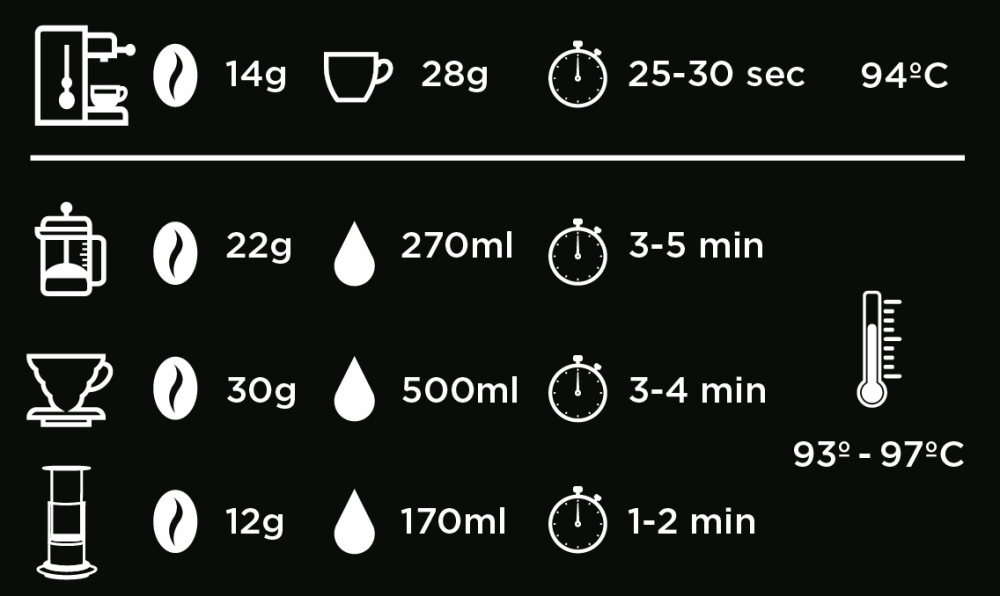Getting the most from our coffee
We’ve put together a list of the most frequently asked questions about our coffee. If you have a question or query which we haven’t answered below, please feel free to get in touch using the form below.
How quickly after roasting should I use your coffee?
All our coffees are roasted fresh each week and the ‘roasted on’ date is printed on the bag. Generally we advise drinking the coffee within one month of roasting. This will ensure you enjoy the product at its very best and is a time when you are most likely to pick out the flavour descriptors on the bag.
Unless packaged in an oxygen free environment, coffee will slowly oxidise, with the more volatile and exciting flavours being the first to be lost. It is difficult to predict how each coffee will react but after around 4 or 5 weeks it may be harder to pick up the fruity notes in the cup, for example.
Research suggests that coffee will not stale for around 3 months but in the intervening period it will drop in quality. Buy little and often is the best option.

I have an espresso machine and have heard of something called ‘degassing’. What is it and what does it mean in practice?
During roasting there is a build up of carbon dioxide in the coffee beans. A large proportion of this gas is released in the 24 hours after roasting (hence the one-way valve on the coffee bags). However, it can often take a few days for the majority of the gas to be released. When it comes to espresso we would advise resting our coffee for 7-10 days after roasting at which point there will be minimal carbon dioxide to affect the extraction.
How should I store your coffee once I have opened the bag? Is the fridge a good place? How about the freezer?
As far as possible you want to protect the coffee from oxygen, heat and moisture. The simplest advice is to reseal the bag, pushing as much air out as possible and then store it in a cool, dry place such as cupboard.
Avoid putting coffee in your fridge as it will readily absorb any moisture or odours. There is some suggestion that freezing coffee prolongs its shelf life. If you take this approach we would advise grinding the beans from frozen and not allowing them to thaw.
You only sell whole beans. Why do you not offer a ground option?
We know that oxygen spoils your coffee. The more of the bean we expose to oxygen, the quicker the coffee will degrade. In our opinion, the exciting and interesting flavours in coffee will all but disappear 20 minutes after grinding. We want you to receive your coffee in the best possible condition and the only way we can achieve this is to sell it as a whole bean.
How much coffee should I use?
All our coffee bags have guidelines on the back for different brew methods. These are given in terms of the amount of coffee to water you should use, and also the approximate time taken to complete the brewing. We suggest you keep as close to these parameters as possible, and vary the grind setting to adjust the character of the coffee.
Our guidelines for espresso are based upon a typical home machine which will usually accommodate no more than 14g of coffee. If you have invested in a more sophisticated home machine you might be able to use a higher dose. It is important to use the correct dose for the baskets you have in your machine. You can always get in touch if you need advice in respect of this.

How fine or coarse should I grind the coffee for my chosen brewing method?
It’s very difficult to give a description of a grind setting but there are a couple of principles to bear in mind. Firstly, the longer the brew time, the coarser the grind needs to be. A coffee press (or cafetière) with a 4 to 5 minute brew time will need a coarser grind to accommodate the slow extraction (maybe along the lines of granulated sugar). Where espresso is concerned, the brew time is short (around 25 seconds), so the grind needs to be much finer. Filter brewing requires something in between as the water passes through the coffee bed slower than for espresso but the overall contact time is less than in a coffee press.
You can also taste the resulting coffee to determine whether the grind setting is correct (if you have been consistent in the amount of coffee and water you have used). If the coffee tastes thin, is overly bright or acidic and lacks a finish, you probably need a finer grind. On the other hand if the coffee has a bitter finish, particularly at the back of the tongue, then we would suggest a coarser grind. Over time you will find the ideal grind setting which best suits the style of coffee you enjoy drinking.
You sell Espresso Blends as well as coffee roasted for filter brewing. What is the difference?
We tend to ‘break down’ the coffee for our espresso blends a little more than we would for filter roasts. This is to compensate for the challenge of brewing a coffee in a machine in just 25 seconds! This increased solubility makes the coffee more consistent to use as well.